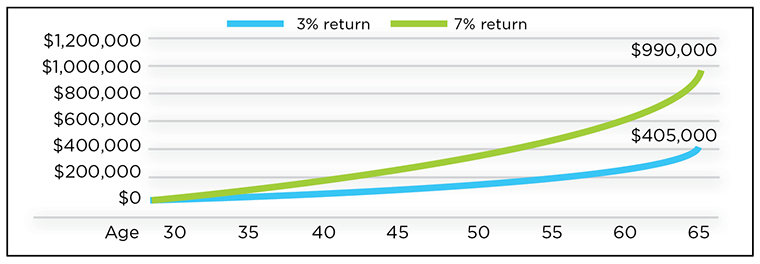I just saw an article with that title above, and quite frankly... it's wrong. And I'll prove it. Here's the original link:
Myth 1. Saving is investing.
While it's important to put money aside in a low, fixed interest rate savings or money market account for emergencies and unexpected expenses, saving money isn't the same as investing. Investing is using your money to potentially create more money over time. There's risk involved with investing, but there's also risk in not investing. If your money doesn’t grow, you may risk not achieving your long-term goals.
This example shows how an investment of $550 a month earning 7% could produce nearly $600,000 more than a savings account earning 3% over the same time period.

This example clearly shows that the person writing this article knows how to use a financial calculator.
Please show me ANY investment that has earned a 7% actual rate of return AFTER investment costs for 30+ years with NO downside market volatility?
Here's the lesson: Math isn't money and money isn't math. Just because you can input 7% in a calculator doesn't mean you're going to earn that... particularly without any market volatility. That graph is just misleading without the proper disclosures. Well, they DID put this underneath it: "Source: Edward Jones. Assumes saving $550 per month rounded to the nearest $5,000. Example is for illustration purposes only and does not reflect the performance of a specific investment."
Myth 2. Buy and sell often.
Being patient can be challenging, but following the latest investment fads and selling every time the market drops won’t get you to your goals. Instead, choose quality investments and have a financial strategy that can weather market ups and downs.
Buy and hold only serves the financial institutions that promote that strategy. It also assumes that they have "all" your money and that you don't have any non-correlated assets that aren't invested with them.
You can search Investopedia.com for various definitions of Correlation. In short, there are other assets that are NOT affected by market swings. Therefore, with that increased liquidity, you can time the economy and decide when you want to put more money back into the market. (I'd never try to "time the market". Markets go up and down for various reasons short-term... but it's easier to try to "time the economy".)
Myth 3. You’re too young or too old.
While it may be best to start early because your money will have more time to grow, it’s never too late to invest. If you’re 50 or older, you may be able to make catch-up contributions to your IRA or 401(k). Or, if you're closer to retirement, there are strategies available that can help ensure your money lasts.
Again, this line of thinking does serve the financial institutions, per my article link above. However, there is truth to this. The younger you are, the better your chances of having the outcomes you want. The older you are... and the more behind you are... the more we would need more creative planning solutions.
Instead of saving dollar-for-dollar for your retirement, we may be able to leverage other assets through leveraging life insurance for pennies on the dollar per year.
For example, if your home is paid off, but you have no other investment assets, it may make far more sense to get a quality life insurance policy to have a way to pay off a potential reverse mortgage against your property. If you don't have the money, your adult children may want to purchase it.
The older we are, the more that creative planning solutions may make far more sense. In short, where would your limited dollars stretch the farthest to get you the results you ultimately want?
Just because an article comes from a well-respected financial institution, doesn't mean that they have only your best interests in mind.

